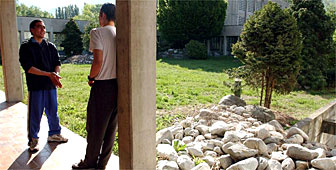First prison for juveniles goes on trial

Switzerland's first prison for juvenile delinquents has five years to prove that it can rehabilitate young offenders.
The Pramont educational centre in Granges, canton Valais, will become a prison and take in its first detainees in 2003. If the system proves successful, other cantons will have ten years to open their own institutions.
Prison experts say there is a need for juvenile detention centres in Switzerland because of the increasing incidence of violent crime among young people.
“This violence and the age of these criminals means it is no longer possible to work within existing structures,” said Christian Varone, director of prisons in canton Valais. “Most of these youngsters suffer from psychiatric problems and are drug users.”
The crimes committed by the young offenders range from murder to theft, and from rape to dealing in drugs. Pramont is the last centre of its type still operating in French-speaking Switzerland.
Juvenile violence
The others closed because of increasing juvenile violence. The Granges centre now takes in young offenders from a variety of cantons, but a lack of space means that many are turned away.
The prison will follow the educational concept used at Pramont since 1998. The prisoners will live together in small groups, and follow basic rules, according to director Pierre-Alain Zufferey.
Educators work with groups of just three detainees, although the makeup of each group changes regularly. The “rotation principle”, as it’s called, helps to prevent groups from forming gangs and attempted escapes.
“Everything is based on mutual respect,” said Zufferey. New arrivals are observed separately at first so as to determine their interests and their capacities.
An individual educational programme is then drawn up for each new detainee.
Carrot-and-stick approach
Life in the prison community follows strict guidelines. “It’s a carrot-and-stick approach,” notes Zufferey. “A youngster who works more and shows more enthusiasm earns more bonus points, either in the form of money or outside leave.”
If the prisoner’s behaviour warrants it, he can then leave the enclosed environment, and eventually live outside the educational centre.
The Pramont prison will have no guards other than the professional educators already working there. “Security is minimal here,” admits Zufferey. “There is always the chance that someone will try to escape.”
Barbed wire could be installed in the future, but nobody will be putting bars on windows as this has been specifically banned.
Pierre-Alain Zufferey remains optimistic about his chances of success. “About one third of those doing time here stay out of trouble, another third live on a knife edge, and the rest are locked up elsewhere,” he said.
swissinfo with agencies

In compliance with the JTI standards
More: SWI swissinfo.ch certified by the Journalism Trust Initiative
You can find an overview of ongoing debates with our journalists here. Please join us!
If you want to start a conversation about a topic raised in this article or want to report factual errors, email us at english@swissinfo.ch.